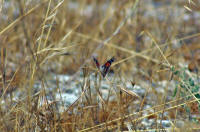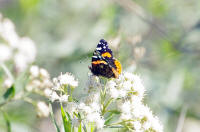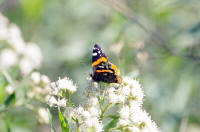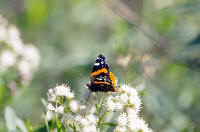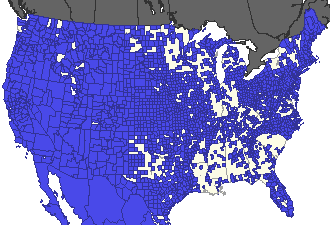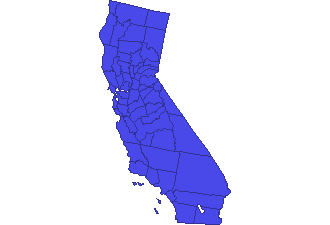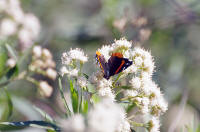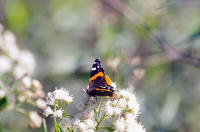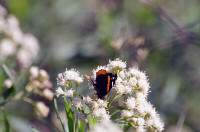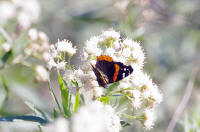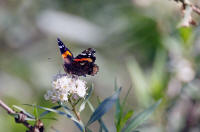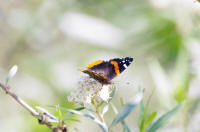|
Taxonomic Hierarchy |
Photo |
|
Kingdom: |
Animalia -- animal |
|
Phylum: |
Arthropoda -- arthropods |
|
Subphylum: |
Hexapoda -- hexapods |
|
Class: |
hexapoda -- insects |
|
Subclass: |
Pterygota -- iwinged insects |
|
Infraclass: |
Neoptera -- modern, wing-folding insects |
|
Order: |
Lepidoptera -- butterflies, moths |
|
Superfamily: |
Papilionoidea -- butterflies |
|
Family: |
Nymphalidae -- admirals, anglewings,
brush-footed butterflies |
|
Subfamily: |
Nymphalinae |
|
Genus: |
Vanessa -- Ladies and Red Admirals |
|
Species: |
Vanessa
atalanta |
|
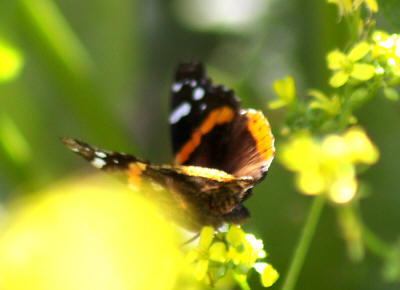 |
|
United States Range Map |
|
California Range Map |
|
|
|
|
|
|
Identification: |
|
Life history:
|
|
Upperside is black with white spots near the apex;
forewing with red median band,
hindwing
with red marginal band. The winter form is smaller and
duller, summer form larger and brighter with an interrupted
forewing band. |
|
The Red Admiral has a very erratic, rapid
flight. Males perch, on ridgetops if available, in
the afternoon to wait for females, who lay eggs singly on
the tops of host plant leaves. Young caterpillars eat and
live within a shelter of folded leaves; older caterpillars
make a nest of leaves tied together with silk. Adults
hibernate. |
|
Flight: |
|
Wing Span: |
|
Two broods from March-October in the north, winters from
October-March in South Texas. |
|
1 3/4 - 3 inches (4.5 - 7.6 cm). |
|
Caterpillar Hosts: |
|
Adult Food: |
|
Plants of the nettle family (Urticaceae) including stinging
nettle (Urtica dioica), tall wild nettle (U. gracilis), wood
nettle (Laportea canadensis), false nettle (Boehmeria
cylindrica), pellitory (Parietoria pennsylvanica), mamaki (Pipturus
albidus), and possibly hops (Humulus). |
|
Red Admirals prefer sap flows on trees, fermenting fruit,
and bird droppings; visiting flowers only when these are not
available. Then they will nectar at common milkweed, red
clover, aster, and alfalfa, among others. |
|
Habitat: |
|
Season: |
|
Moist woods, yards, parks, marshes, seeps, moist fields.
During migrations, the Red Admiral is found in almost any
habitat from tundra to subtropics. |
|
|
|
Remarks: |
|
Conservation: |
|
Caterpillar makes a larval shelter, either tying up the
leaves of a shoot tip, or usually later in the life cycle
rolling a leaf. |
|
Conservation: Not required.
NatureServe Global Status:
G5 - Demonstrably secure globally, though it may be quite
rare in parts of its range, especially at the periphery.
Management needs: None reported.
|
|
Sources used to
Construct this Page: |
|
|
|
|
|
|
NatureServe is a non-profit conservation
organization. Global ranks indicate the rarity of a species at a
global scale. Species may be fairly common globally but imperiled
locally. Global ranks have the following meaning:
- G1 - Critically Imperiled - At very high risk of extinction
due to extreme rarity (often 5 or fewer populations), very steep
declines, or other factors.
- G2 - Imperiled - At high risk of extinction due to very
restricted range, very few populations (often 20 or fewer),
steep declines, or other factors.
- G3 - Vulnerable - At moderate risk of extinction due to a
restricted range, relatively few populations (often 80 or
fewer), recent and widespread declines, or other factors.
- G4 - Apparently Secure - Uncommon but not rare; some cause
for long-term concern due to declines or other factors.
- G5 - Secure - Common; widespread and abundant.
- * ? or Q = status unknown or uncertain
|
